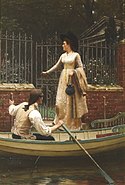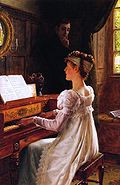Edmund Leighton
Edmund Leighton | |
|---|---|
 Leighton in 1900 | |
| Born | Edmund Blair Leighton 21 September 1852 London, England |
| Died | 1 September 1922 (aged 69) London, England |
| Nationality | British |
| Known for | Painting |
Edmund Blair Leighton ROI (21 September 1852 – 1 September 1922) was an English painter of historical genre scenes, specialising in Regency and medieval subjects. His art is associated with the pre-Raphaelite movement of the mid-to-late nineteenth and early twentieth centuries.[1]
Biography
[edit]Leighton was the son of the artist Charles Blair Leighton (1823–1855) and Caroline Leighton (née Boosey). He was educated at University College School, leaving at 15 to work for a tea merchant. Wishing to study art, he went to evening classes in South Kensington and then to the Heatherley School of Fine Art in Newman Street, London. Aged 21, he entered the Royal Academy Schools.[2][3] Among his first commissions were monochrome illustrations for Cassell's Magazine and its Book of British Ballads.[3] His first painting to be exhibited at the Royal Academy was A Flaw in the Title in 1874; it sold for £200. He soon gave up "black and white" illustrations, working for the rest of his career in oil on canvas.[3] He married Katherine Nash in 1885; they had a son, the painter Edmund J. Blair Leighton, and a daughter. He exhibited annually at the Royal Academy until 1920.
Leighton was a fastidious craftsman, producing highly finished, decorative historical paintings. These were romanticised scenes, often of chivalry and women in medieval dress with a popular appeal.[4] It would appear that he left no diaries, and though he exhibited at the Royal Academy for over forty years, he was never an Academician or an Associate.
Works
[edit]-
Old Times (1877)[5]
-
Till Death Do Us Part (1878)
-
Faded Laurels (1889)
-
Lady Godiva (1892)[6]
-
The Elopement (1893)
-
My Next-Door Neighbour (1894)
-
In 1816 (1895)
-
In Time of Peril (1897)[4]
-
Off (1899)[8]
-
On the Threshold (1900)[9]
-
God Speed! (1900)
-
The Accolade (1901)[6]
-
Tristan and Isolde or The End of the Song (1902)
-
Courtship (1903)
-
The Queen kisses the sleeping poet Alain Chartier (1903)[10]
-
Courtship by the Piano (1903)
-
Ribbons and Laces for Very Pretty Faces (1904)
-
The Dedication (1908)
-
To the Land Unknown (1911)
-
Stitching the Standard (1911)[11]
-
The Boyhood of Alfred the Great (1913)
-
My Fair Lady (1914)
-
The Charity of Elisabeth of Hungary (1915)
-
The Hostage (1912)
Among Leighton's other works are:
- Un Gage d'Amour (1881), Auckland Art Gallery Toi o Tamaki.[12]
- Conquest (1884)[13]
- The Rehearsal (1888), Croydon Clocktower, UK.[6]
- How Liza Loved the King (1890), Towneley Hall Art Gallery and Museum, Burnley.[6]
- Waiting for the Coach (1895), Manchester Art Gallery.[14]
- On the Threshold (1900), Manchester Art Gallery.[9]
- The Accolade (1901), private collection.[6]
- Adieu (1901), Manchester Art Gallery.[15]
- The Shadow (1909), City Hall, Cardiff[16]
- A Nibble (1914), private collection.[6]
- An Arrival (1916), City Hall, Cardiff[16]
- The Lord of Burleigh, Tennyson (1919), private collection.[6]
- Sweet Solitude (1919), private collection.[6]
- After Service (1921), private collection.[17]
- Signing the Register (undated), Bristol City Museum and Art Gallery.[6]
- The Fond Farewell (1891), Messum's, London.[6]
- Lord of the Manor (undated), private collection.[6]
- Sorrow and Song (undated), Bristol City Museum and Art Gallery.[6]
References
[edit]- ^ de La Sizeranne, Robert (2008). The Pre-Raphaelites. Parkstone Press International. p. 24.
- ^ Yockley 1913.
- ^ a b c De Cordova 1905.
- ^ a b "In Time of Peril". Auckland Art Gallery. Retrieved 18 January 2021.
Edmund Blair Leighton specialised in the historical genre that stood at the apex of the academic system, edifying audiences with scenes of chivalry as well as entertaining them with glimpses of Lady Godiva.
- ^ "Old Times by Edmund Leighton". leicestergalleries.com. Archived from the original on 12 October 2007.
- ^ a b c d e f g h i j k l m Listed at Bridgeman Art Library Archived 22 August 2013 at the Wayback Machine.
- ^ ""A King and a Beggar Maid"". Sotheby's. Retrieved 18 July 2016.
- ^ "Off". Manchester City Galleries – Search the collection.
- ^ a b "On the Threshold". Manchester City Galleries – Search the collection.
- ^ "Live Auction 6520, Lot 27". Christie's. 28 November 2001. Retrieved 18 January 2021.
- ^ The painting was named as "Preparing the Flag" at Christies in 1928, and as "Awaiting his Return" at Philips in 1977. Sotheby's called it "Stitching the Standard" in 1978. It may be the painting catalogued as "The Device" in 1911. "Victorian & Edwardian Art" (PDF). Sotheby's. 15 November 2011. Archived from the original (PDF) on 24 September 2015. Retrieved 28 June 2014.
- ^ "Un Gage d'Amour". Auckland Art Gallery Toi o Tamaki. Archived from the original on 6 October 2014. Retrieved 12 August 2012.
- ^ "Conquest". Sotheby's. Archived from the original on 24 September 2015.
- ^ "Waiting for the Coach". Manchester City Galleries – Search the collection.
- ^ "Adieu painting". Manchester City Galleries – Search the collection.
- ^ a b "Visitor Information Guide" (PDF). Cardiff City Hall. 2006. Archived from the original (PDF) on 10 July 2007.
- ^ "After Service by Edmund Leighton". leicestergalleries.com.[dead link]
Bibliography
[edit]- De Cordova, Rudolph (1905). "The Art of Mr. E. Blair Leighton". The Windsor Magazine. 21 (December 1904 to May 1905). London: Ward, Lock & Co. Archived from the original on 18 September 2016.
- Yockley, Alfred (December 1913). "The Art of Edmund Blair Leighton". Art Annual (Christmas 1913). London: 11, 31, illustrations.
External links
[edit]- 1852 births
- 1922 deaths
- 19th-century English painters
- English male painters
- 20th-century English painters
- British genre painters
- People educated at University College School
- Alumni of the Heatherley School of Fine Art
- Alumni of the Royal Academy Schools
- 19th-century English male artists
- English children's book illustrators
- Members of the Royal Institute of Oil Painters
- 20th-century English male artists

![Old Times (1877)[5]](http://upload.wikimedia.org/wikipedia/commons/thumb/5/5c/Edmund_Blair_Leighton_-_Old_Times.jpg/118px-Edmund_Blair_Leighton_-_Old_Times.jpg)

![Abelard and his Pupil Heloise (1882)[6]](http://upload.wikimedia.org/wikipedia/commons/thumb/8/87/Edmund_Blair_Leighton_-_Abelard_and_his_Pupil_Heloise.jpg/123px-Edmund_Blair_Leighton_-_Abelard_and_his_Pupil_Heloise.jpg)

![Lady Godiva (1892)[6]](http://upload.wikimedia.org/wikipedia/commons/thumb/5/53/Leighton-Lady_Godiva.jpg/185px-Leighton-Lady_Godiva.jpg)



![In Time of Peril (1897)[4]](http://upload.wikimedia.org/wikipedia/commons/thumb/2/29/Edmund_Blair_Leighton_-_In_Time_of_Peril_-_Google_Art_Project.jpg/185px-Edmund_Blair_Leighton_-_In_Time_of_Peril_-_Google_Art_Project.jpg)
![The King and the Beggar-maid (1898) (legend)[7]](http://upload.wikimedia.org/wikipedia/commons/thumb/6/64/Leighton-The_King_and_the_Beggar-maid.jpg/139px-Leighton-The_King_and_the_Beggar-maid.jpg)
![Off (1899)[8]](http://upload.wikimedia.org/wikipedia/commons/thumb/d/db/Leighton-Off-1900.jpg/136px-Leighton-Off-1900.jpg)
![On the Threshold (1900)[9]](http://upload.wikimedia.org/wikipedia/commons/thumb/6/62/Edmund_Blair_Leighton_-_On_the_Threshold.jpg/132px-Edmund_Blair_Leighton_-_On_the_Threshold.jpg)

![The Accolade (1901)[6]](http://upload.wikimedia.org/wikipedia/commons/thumb/3/38/Accolade_by_Edmund_Blair_Leighton.jpg/108px-Accolade_by_Edmund_Blair_Leighton.jpg)


![The Queen kisses the sleeping poet Alain Chartier (1903)[10]](http://upload.wikimedia.org/wikipedia/commons/thumb/1/12/Leighton-Alain_Chartier-1903.jpg/126px-Leighton-Alain_Chartier-1903.jpg)




![Stitching the Standard (1911)[11]](http://upload.wikimedia.org/wikipedia/commons/thumb/0/0c/Leighton-Stitching_the_Standard.jpg/83px-Leighton-Stitching_the_Standard.jpg)



